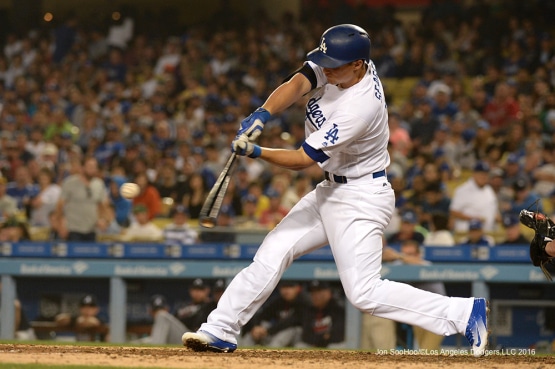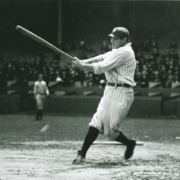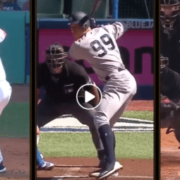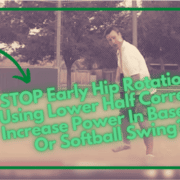Corey Seager & Trevor Story: How To Offensively Win Rookie Of The Year
Here Is A Formula That Is Helping Corey Seager Or Trevor Story Win NL Rookie Of The Year

Corey Seager getting great knee action here, being slightly out front of the pitch. Photo by Jon SooHoo/© Los Angeles Dodgers,LLC 2016
I’ve been watching quite a bit of the Los Angeles Dodgers lately (because of my fanatic mother-in-law),
And am really impressed with Corey Seager’s swing, who’s 6’4″, 215-lbs (according to FanGraphs.com).
So I decided to do a comparison between a couple leading 2016 NL Rookie of the Year candidates, Seager and Trevor Story of the Colorado Rockies, who’s 6’1″, 175-lbs (according to FanGraphs.com).
Granted, at the time of this writing (8/23), Story has cooled down a bit, and is sitting on the Disabled List with a torn ligament in his thumb.
So, here’s what we cover in the Corey Seager v. Trevor Story hitting analysis video:
- Talking metrics,
- Catapult Loading System swing elements,
- Pitch-Plane Domination swing elements,
- Reaction Time Mastery swing elements, and
- Adjustments to off-speed or breaking stuff.
Talking Metrics
First let me define a couple of the metrics we’ll be looking at:
- ISO – Isolated Slug%, basically raw power, and
- BABIP – Batting Average on Balls In Play, a loose measure of how consistently a hitter hits the ball hard.
Okay, so now let’s compare their lines according to Fangraphs.com…
Corey Seager

Compliments of Fangraphs.com
And…
Trevor Story

Compliments of Fangraphs.com
In comparing Corey Seager to Trevor Story’s metrics, you can see Seager has a bit more consistency baked into his swing, but Story has a bit more power…possibly due to the thin air in Colorado, I dunno, just sayin’. lol
And if you look at the percentages of:
- Ground-balls (GB%, league average is 44%),
- Line Drives (LD%, league average is 20%),
- Fly-balls (FB%, league average is 36%), and
- Homers to Fly-Balls (HR/FB, league average is 9.5%)…
…Between the two hitters, you can see there’s no secret to what Trevor Story is trying to do with his swing…get the ball in the air!! The thin air!
Corey Seager

And…
Trevor Story

NOTES about Video Analysis

Trevor Story getting a significant positive attack angle, one of the reasons he gets the ball in the air so well. Photo courtesy: Deadspin.com
The Corey Seager homers analyzed…
Game footage was from 8/8/2016 – 2 homers:
- 91-mph FB, down-middle
- 75-mph CB, down-middle
The Trevor Story homer analyzed…
Game footage was from 7/24/2016 – 1 homer:
- 81-mph CU, down-inner 1/3
The rest of the video, after discussing metrics, was looking at how well Corey Seager and Trevor Story used the following HPL formula:
- Catapult Loading System,
- Pitch-Plane Domination, and
- Reaction Time Mastery.
What’s interesting to note on adjustments to off-speed or breaking balls…both hitters “get shorter” and “stay shorter” to buy themselves some time, while also trying to “stay underneath” the ball.
Both Corey Seager and Trevor Story are great examples of the formula we use at HPL to help hitters triple their body-weight in batted ball distance…
They don’t have to hit all the ‘musical notes’, but definitely a majority.
It’s a great formula for winning NL Rookie of the Year 😉
- Best Youth Baseball Hitting Program to Boost Rotational Power Fast—Trusted by MLB’s Rajai Davis & Built on the Catapult Loading System - June 22, 2025
- The #1 Arm Care Program for Youth Baseball: Why Top Travel Coaches Trust Jaeger’s J-Bands & Long Toss Routine to Prevent Injury Fast - June 3, 2025
- Are Baseball Hitting Lessons Worth It in 2025? Fix Your Kid’s Swing Fast With Pro-Approved Drills (Before You Waste Another $60) - May 29, 2025












Awesome video once again… I love the adjustments and that back leg bent stays strong sort of… I remember hitting a ball hard in softball and I misjudged the hell of a slow pitch softball…go figure…and I just about fell to the ground before I hit it…but everyone told me how my back leg was bent and so strong… I remember thinking I wasn’t thinking of my back leg at all and I was thinking wait wait wait and as I was waiting my front leg does and did exactly what you were saying… Bought me time and as I was still able to coordinate it all…my back side just did its thing and keep me from falling and yea I hit that baby hard really hard…Obviously I can talk about all that I agree but no point there…
I would have loved to see the hands in super slow mo… And see after he plays puppet master with his strings where would they be around GO and than at right before contact and through contact…So I’m saying I bet his hands move slightly even more…And I think door knockers follows some logic about Palm up Palm down… I think the lead wrist rolls… Not really in a Palm down and flat way… More of a roll….
I love your buying time… And by buying time the batter lost that perfect look so many want to see and so easily start saying he could have done this better or that better… But at the end did he do damage… Yes… And if the batter bought time and squared it… The best thing is to see where he leaked in order to figure out how the adjustment was made…
Shoot I don’t want to comment forever but doesn’t this illustrate that timing and the swing are different…. You can’t adjust the ball as its thrown but you can adjust the swing if you mis timed it as is almost all the time…
Seriously great video…Trying to figure out the adjustments is not easy….teaching it I would believe is even harder…I can pinch myself at the difficulty… Later!
~DM
Joey Quick question… How do you explain lag… This might be where I might best explain things…Also do you teach bottom and top hand torques…
Hey Joey, question how accurate do you think the Zepp baseball application is for MPH of swing. I would love to see a radar measuring ball exit speed facing you on a tee and compare those numbers to the Zepp. I have seen kids register 90mph off a tee and not even sniff the outfield during BP while others have registered 78-80 mph and hit balls over the fence in the same BP session?
Thanks for any input and would love to see you test the Zepp with a Radar. I know there will be slight variations but wonder if the Zepp tends to not be as accurate.
I tend to see when I hit a ball pretty high MPH on the Zepp the next few swings seems to be high as well even though I know I have not hit those balls any harder than previous balls hit.
Brad, Zepp and a radar gun are measuring two different things…at least in the example you gave. Zepp measures Bat Speed at Impact, it cannot measure Ball Exit Speed, which is what you’re measuring when you sit behind or in front of a hitter and radar gun the ball exiting speed. This is an apples to oranges comparison. However, addressing your question of how accurate the Zepp is…it really doesn’t matter, unless you’re recruiting players and need precision. What I mean by that is that if you’re using Zepp as a teaching or experimentation tool, then all you need is an apples to apples comparison. Zepp or SwingTracker are great for that, although I hear SwingTracker is more accurate. Basically, they’re an expensive calculator 😉
Wouldn’t it make more sense to use ball exit speed than Zepp to prove most of your experiments. Say no stride vs stride for power. I would think Ball Exit is more important. If I can’t hit the ball further I don’t care what the Bat speed at impact is.
I just don’t think that translates into more power compared to a radar, but would be neat to use both next time you do something like that. I just know I can register 90mph swings sometimes and other times 70’s, it just doesn’t seem very consistent.
Never bad to have another tool just buggs me so many college showcases use it when i am not sure how it translates to hitting on the field. Anyway keep up the good work.
It would actually be better to do swing experiments measuring BES over Zepp metrics. And I have done that on a few experiments already. However, I think showing an average difference in bat speed of 6-mph with swing mechanic A v. swing mechanic B is irrelevant, whether you’re capturing BES or bat speed. It still shows an inferior swing mechanic. The point of the Scientific Method is to have an apples to apples comparison. That being said, I have plans to do a handful of my experiments over measuring and comparing BES.